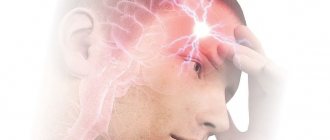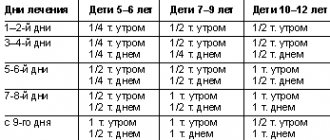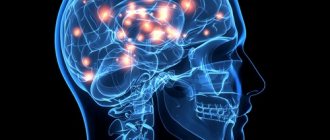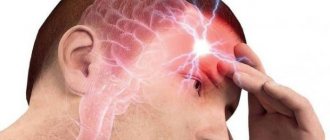These are not yet established symptoms, but the pattern of their appearance after physical or psychological stress is clearly visible. Sometimes symptoms of VSD appear in a child after an infectious disease, or as a reaction to some drug. In childhood, the prevention of dystonia is especially effective, since all systems continue to develop until the age of 18-21.
Causes
The causes of vegetative-vascular dystonia in children, as a rule, are hereditary phenomena and are caused by deviations in the work and structure of different parts of the autonomic nervous system, which are transmitted through the mother. The development of such syndromes in children can be facilitated by various complications during pregnancy and childbirth, for example, severe toxicosis, intrauterine infections, fetal hypoxia, injuries received during childbirth, encephalopathy. Protracted labor or, conversely, too rapid labor can also have a negative impact.
Also of particular importance in the development of VSD in a child are influences that traumatize the psyche, for example, his family may be too conflicting. Frequent and severe stress, excessive care, problems at school, and excessive stress during training also affect.
Predisposing factors that contribute to the development of vegetative-vascular dystonia in children include infectious, somatic and endocrine diseases, and allergic reactions. Affected by abnormal development of organs, skeleton, anemia, head injuries. As for infections, you should be most wary of neuroinfections and focal ones. The latter include caries, sinusitis, pharyngitis, and chronic tonsillitis.
In addition to these risk factors, there are also immediate triggers that can provoke the appearance of autonomic dysfunction. These may include unfavorable climatic and weather conditions, poor ecology, a sedentary lifestyle or, conversely, excessive debilitating physical activity, as well as vitamin deficiencies, disrupted work and rest schedules, poor nutrition, and hormonal imbalances during puberty. Most often, autonomic disorders are activated in children during the period of active growth, when there is a large load on their body, and the nervous system is not stable.
Diagnostics
Determining VSD is a serious multi-step process, since the syndrome is established by exclusion. The specialist should carry out a number of diagnostic measures and consider or reject other possible problems. Only after this a set of therapeutic actions is selected.
A neurologist conducts a preliminary examination of the baby and then refers the teenager or infant to other specialists. Such measures are necessary to exclude any other organic and psychopathic diseases.
Diagnosis of vegetative-vascular dystonia is carried out in 3 stages:
- Anamnesis collection. Developmental features are clarified, and the presence of bad habits in the baby or adults during gestation is established. Hereditary factors, as well as prenatal development, are important factors in the development of the problem.
- Attention is focused on the functioning of the central nervous system. The child is prescribed additional hardware tests - EEG, ultrasound, ultrasound.
- Based on the data obtained, experts exclude the presence of possible pathologies characterized by similar discomfort.
In the absence of pathological physical and mental disorders, a diagnosis of VSD is established. Based on the severity of the condition and the symptomatic picture, comprehensive treatment measures are carried out. Therapy takes a long time - more than 1.5–2 months.
Classification
When diagnosing VSD in a child, doctors take into account a number of criteria that help determine the form of the disorder. Depending on the etiology, the following types of syndrome are distinguished:
- neurotic (psychogenic);
- toxic-infectious;
- dishormonal;
- hereditary;
- mixed.
According to the nature of the disorders, they are distinguished:
- vagotonic;
- sympathicotonic;
- mixed.
Depending on the prevalence of pathological processes, vegetative-vascular dystonia can be local, systemic and generalized.
Vegetative-visceral disorders in newborns with perinatal brain lesions
The leading link in the formation of vegetative-visceral disorders is damage to the diencephalic structures of the brain, limbic system, medulla oblongata and subsequent disorder of neuroendocrine regulation
Vegetative-visceral disorders in newborns mean a wide range of morphological and functional changes in many organs and systems, referred to as somatoneurological, neurosomatic or neuroendocrine.
This mainly refers to vascular, gastrointestinal disorders, as well as thermoregulation disorders. With any of the clinical and neurological syndromes, somatic disorders of varying severity may be observed. Thus, the syndrome of general depression, as a rule, is accompanied by respiratory disorders, disturbances of vascular tone and thermoregulation, a syndrome of increased neuro-reflex excitability and hypertensive-hydrocephalic - dysregulation of the sphincters, impaired motility of the gastrointestinal tract. The syndrome of vegetative-visceral disorders is often attributed to the recovery period of encephalopathy, when, against the background of the subsidence of the neurological disorders themselves, the normalization of muscle tone and the reflex sphere, these disorders come to the fore and dominate the clinical picture of encephalopathy. According to our clinic, the frequency of vegetative-visceral disorder syndrome in children of the first year of life who have suffered perinatal encephalopathy is about 10%; however, in other recovery period syndromes, along with predominant neurological disorders (motor or psychoemotional), individual somatovegetative abnormalities may be noted.
| In the practice of a pediatrician, special importance is attached to the following functions of the autonomic system: regulation of vascular tone and cardiac activity, regulation of the secretory activity of the endocrine glands, thermoregulation, regulation of metabolism, influence on smooth muscles, adaptive-trophic influence on receptors and synapses |
The leading link in the formation of vegetative-visceral disorders is damage to the diencephalic structures of the brain, limbic system, medulla oblongata, and subsequent disorder of neuroendocrine regulation. In newborns, especially premature infants, the higher autonomic centers are underdeveloped, including the sympathetic system of the spinal cord and borderline sympathetic trunk and the parasympathetic nuclei of the midbrain. In this regard, the role of the hypothalamus and limbic-reticular system (paraventricular and supraoptic nuclei, hippocampus and amygdala nucleus) increases significantly. The hypothalamus, through the regulation system “Pituitary gland - thyroid gland - adrenal glands”, carries out the integration of adaptation processes. Each section of the hypothalamus regulates a specific function of the sympathetic and parasympathetic nervous system.
Experimental studies have established that irritation of the posterior parts of the hypothalamus leads to sympathicotonia, increased blood pressure, and decreased body temperature; pathological processes in the posterior parts of the hypothalamus contribute to trophic disorders and sexual infantilism. The anterior parts of the hypothalamus (primarily the limbic system) are associated with the regulation of water and salt metabolism, sleep and wakefulness.
In the practice of a pediatrician, special importance is attached to the following functions of the autonomic system: regulation of vascular tone and cardiac activity, regulation of the secretory activity of the endocrine glands, thermoregulation, regulation of metabolism, influence on smooth muscles, adaptive-trophic influence on receptors and synapses.
Indicators of the state of the autonomic nervous system in newborns
|
Violation of any of these functions (isolated or in combination with other disorders) is possible with perinatal encephalopathies. The morphological substrate of the lesion can be either a transient circulatory disorder in the diencephalic-hypothalamic region or persistent ischemic disorders and hemorrhages. As a rule, we are talking about circulatory disorders in the middle and posterior cerebral arteries. Severe somato-vegetative disorders develop with intraventricular hemorrhages, typical of perinatal brain lesions in extremely low birth weight children (deep coma, respiratory disorders, hypo- and hyperthermia, cardiac disorders, trophic dysfunctions). Among hemorrhages of other localizations, subependymal hemorrhages should be mentioned, which can be observed when small veins rupture between the caudate nucleus and the optic thalamus; they can destroy the head of the caudate nucleus, which leads to severe disorders of vegetative-trophic functions.
The clinical manifestation of the syndrome of vegetative-visceral disorders in newborns is vegetative-vascular dysfunction (lability of vascular tone and heart rate). The child has a “marble” skin pattern and transient cyanosis. In premature babies, due to the immaturity of the centers regulating vascular tone, changes in skin color, cyanosis of the feet and hands are more pronounced than in full-term babies. It is believed that even practically healthy premature babies in the first weeks of life are prone to hypostasis, that is, to the accumulation of blood in the underlying sections. Very premature infants may experience Finkelstein's (or Harlequin's) sign. If this symptom is observed in more mature children, it indicates damage to the diencephalic vasomotor centers or insufficiency of adrenal function.
The disturbances in vascular tone described above in the syndrome of autonomic-visceral disorders are accompanied by changes in blood pressure and pulse rate lability. The level of blood pressure during a single measurement can be either increased or decreased: for an adequate assessment of blood pressure, it is necessary to measure it at least 8 times a day, during the day and at night.
Equally important is the measurement of CO2 and pCO2. It has been established that in healthy children, in the first weeks of life, a gradual formation of the blood pressure biorhythm occurs - an increase in its amplitude, a shift in maximum blood pressure values to the second half of the day. With mild and moderate manifestations of perinatal encephalopathy, a delay in the formation of daily and weekly rhythms in hemodynamic parameters is possible, with severe ones - a significant disruption in the formation of biorhythms, a decrease in average daily indicators with a shift in systolic and diastolic blood pressure - a very small amplitude, sharp fluctuations in blood pressure amplitudes; all this indicates a violation of autoregulation of blood circulation. Lability of blood pressure in the syndrome of vegetative-vascular disorders is accompanied by lability of heart rate and heart rate.
The number of heartbeats varies from minute to minute within 5-10%. Unlike tachycardias associated with cardiac conduction disturbances, there are no corresponding R and T waves on the ECG and no rigid stability of the R-R intervals. Increased intracranial pressure may be accompanied by persistent bradycardia. Sometimes these heart rhythm disturbances in perinatal encephalopathies are accompanied by metabolic changes in the myocardium (according to ECG data), systole-diastolic murmurs (in the absence of persistent fetal communications).
| The most informative indicators of the child’s vegetative status are: the condition of the skin, heart rate, blood pressure on the right and left arm, breathing rate |
Respiratory disorders in the syndrome of vegetative-visceral dysfunctions are usually combined with cardiovascular disorders (attacks of bradypnea and periodic apnea, or tachycardia and tachypnea, respectively) and with lability of vascular tone. This is due to the general mechanisms of disruption of neuroendocrine regulation in the hypothalamus-pituitary-adrenal system and the thyroid gland. Severe forms of respiratory disorders [respiratory disorder syndrome (RDS) of central origin], as a rule, are not classified as vegetative-visceral disorders. The latter include milder functional changes that are not accompanied by serious disturbances of homeostasis. In premature infants, apnea of 10 to 12 seconds combined with periods of bradycardia may be due to general immaturity.
Closely related to disturbances in vascular tone is a manifestation of vegetative-visceral syndrome such as a violation of thermoregulation. In full-term infants, it can manifest itself in the form of prolonged low-grade fever, a distortion of the nature of the temperature curve (morning is higher than evening); in premature infants in incubators, most often in the form of a tendency to overheat. Local hypothermia (cold extremities at normal or elevated body temperature) and asymmetry of skin temperature are also possible (Fig. 1).
| Figure 1. Skin temperature (°C) in premature newborns |
One of the most common manifestations of autonomic-visceral dysfunction syndrome is various dyskinesias of the gastrointestinal tract. Depending on the predominant damage to the sympathetic and parasympathetic parts of the autonomic nervous system, hyper- and hypomotor types of intestinal dyskinesia and various dysfunctions of the sphincters (gaping or spasm) may be observed.
Often there are such forms of dysfunction of the gastrointestinal tract as persistent vomiting and regurgitation (functional obstruction), which can be caused by chalasia cardia and incoordination of the esophagogastric sphincter. Persistent dilatation of the cardiac sphincter leads to gastroesophageal reflux and esophagitis. In turn, esophagitis can cause cardiovascular failure, since it increases the sympathicotonia characteristic of newborns and provokes viscero-visceral reflexes, which reduce coronary blood flow.
Vomiting and regurgitation during perinatal encephalopathy can also be caused by a lack of inhibition of gastric motility during and immediately after feeding, as shown by ultrasound and electrogastrography. A dangerous complication of regurgitation and vomiting is aspiration syndrome with the subsequent development of aspiration pneumonia. Pylorospasm and, less commonly, duodenospasm can also lead to the syndrome of regurgitation and vomiting; As a rule, these types of gastrointestinal dyskinesias are accompanied by stool retention.
With irritation of the parasympathetic departments, increased frequency of stools and increased intestinal motility are possible; for spinal lesions, flatulence and weakened peristalsis are more typical. As a rule, with pronounced vegetative-visceral disorders, changes in the gastrointestinal tract quickly lose their purely functional character - dysbiosis, secondary enzymatic deficiency, malabsorption, and nutritional disorders are layered. All of the above-described systemic disorders in perinatal encephalopathy can be observed both in combination and in isolation.
The leading importance in establishing the diagnosis of the syndrome of autonomic-visceral disorders of cerebral origin is the corresponding clinical picture and the exclusion of organ pathology (pyloric stenosis in regurgitation syndrome; cardiopathy in cardiovascular disorders, etc.). However, in neonatology, additional methods for diagnosing and assessing the severity of autonomic dysfunctions can be used.
The most informative indicators of the child’s vegetative status are: the condition of the skin, heart rate, blood pressure on the right and left arms, and respiratory rate (RR). The following tests help to identify the characteristics of autonomic disorders: orthostatic, epigastric, oculocardiac (Aschner test).
More severe forms of encephalopathy are accompanied by more pronounced asymmetry of skin temperature (in both central and peripheral areas, while in milder forms - only in the upper half of the body). The most persistent and pronounced changes in functional tests were observed in the least mature (very premature) children.
In order to assess the nature of autonomic dysfunctions, select therapy and predict long-term pathology, long-term monitoring of hemodynamic parameters and ultrasound monitoring of the dynamics of cerebral blood flow, especially in the middle and posterior cerebral arteries (Doppler study), are advisable. Due to the widespread use of ultrasound in newborns, REG research is relegated to the background, although with the help of REG it is possible to evaluate the child’s reactions to an orthostatic test.
Follow-up observations in severe encephalopathy have shown that autonomic disorders can persist for several years, while being combined with various motor disorders, astheno-neurotic conditions, and minimal cerebral dysfunction (MCD). These disorders are most often characterized by vegetative-vascular dystonia of the hypertonic (less often hypotonic) type, thermoneuroses, and perverted reactions to functional tests. Almost all children have long-term asymmetry of skin temperature; some have persistent heart rhythm disturbances and mild systolic murmur. Most of these children belong to the group of people who suffer from ARVI frequently and for a long time.
Premature children born to mothers with VSD and having a sharp “marbling” of the skin in the neonatal period at the age of 6 - 14 years have a high probability of developing functional hypothalamic syndromes, accompanied by emotional-volitional and neuroendocrine disorders (thyroid dysfunction, obesity, delayed puberty and so on.).
In the treatment of autonomic-visceral dysfunctions in newborns, two approaches are combined - pathogenetic and syndromic. The first includes effects aimed at correcting metabolic disorders, disorders of cerebral blood flow and improving the rheological properties of blood. For severe lesions with pronounced changes in metabolism, respiratory and cardiovascular disorders, intensive therapy is carried out, including oxygenation, antioxidant therapy, infusions of antihemorrhagic and antihypoxic drugs, hormones and antibiotics, and vitamin-energy mixtures.
The leading place in pathogenetic therapy belongs to non-drug effects. Various types of therapeutic massage, exercises in water and dry immersion have a complex regulatory effect on the mechanisms of neuroendocrine regulation and autonomic centers.
Among the traditional physiotherapeutic methods of treatment, electrophoresis is used (with magnesia, aminophylline, vitamins), often on the cervical (“collar”) area.
Conventionally, physical methods of influence can include aeroion therapy (Chizhevsky lamp), aromatherapy, and it is possible to use music therapy, the choice of which is determined by the predominance of depression in the child (in particular, with arrhythmia of breathing) or agitation (for example, with regurgitation syndrome). In the first case, a program of activating music is used (Mozart, the first part of “A Little Night Serenade”, Schubert, etc.), in the second - a calming program (lullabies, some works by Bach, etc.). When alternating lethargy and excitement, the effectiveness of V.V. Kiryushin’s program (alternating pitch exercises of different types) has been established.
Syndromic therapy of some vegetative-visceral disorders involves the use of various medications. Thus, for gastrointestinal dyskinesia syndrome, drugs are used that act on diencephalic structures and peripheral receptors - cerucal, bimoral, no-spa, nouspasm, pipolfen, aminazine. For the hypomotor type of dyskinesia of the stomach and intestines, prozerin is sometimes used. To correct concomitant dysbiosis, eubiotic drugs and enzymes are used. When a combination of slowing cerebral blood flow, according to ultrasound, and lability of the general vascular tone (“marbling” of the skin), Cavinton or Vinpocetine, piracetam are used. However, it should be noted that drug therapy is rarely the mainstay. To correct mild vegetative-visceral disorders, sometimes it is enough to normalize environmental conditions (routine, nutrition, walks, quiet environment).
Symptoms
Symptoms of vegetative-vascular dystonia in children are very diverse. Specific signs are not identified, because of this, parents are often mistaken when the baby complains of being unwell. The manifestations of various symptoms can be perceived as characteristic signs of diseases of different systems and organs.
You should be wary if your child has the following symptoms:
- mood changes sharply - anxiety, panic, tearfulness, fears and apathy;
- decreased activity;
- problems with sleep - either drowsiness or, on the contrary, insomnia;
- the skin becomes dry, acne appears due to the disruption of the sweat and sebaceous glands;
- sudden changes in temperature;
- diarrhea, nausea and vomiting, increased or, conversely, decreased salivation, decreased appetite, abdominal pain;
- shortness of breath, breathing problems.
Vegetative-vascular dystonia can be either a primary disease (develops independently) or secondary (that is, it manifests itself due to other diseases). The severity of the disorder depends on how many symptoms appear and their severity.
Vegetative-vascular dystonia can manifest itself in the form of cardioneurosis. Most often it takes the following forms:
- hypertensive. The main symptom is increased blood pressure;
- hypotonic. Blood pressure decreases;
- cardiac. The rhythm of the heart is disrupted;
- mixed. All the previously listed symptoms appear in varying degrees and combinations.
Also, VSD in children can take the form of respiratory neurosis. In this case, breathing problems appear: lack of oxygen, frequent sighs, shortness of breath, pauses when exhaling.
If VSD has affected the digestive system, then problems with digesting food appear: dyspeptic disorders, hiccups, abdominal pain. With spasms of the esophagus, chest pain occurs, which is aggravated by swallowing. Children often experience dyskinesia of the bile ducts with the outflow of bile.
There are also other options for the manifestation of VSD in childhood:
- thermoregulation is disrupted. During the day the temperature rises, but only slightly, and at night it returns to normal. Also, if you check the temperature in different armpits, the indicator will be slightly different. The child may complain of chills;
- problems with urination. Emptying the bladder occurs rarely, but in large portions. The child strains at this. The completely opposite situation is also possible;
- neurotic symptoms. This can be anxiety, lethargy, hysterics, fears, apathy, depression, fatigue and even hypochondria.
With vegetative-vascular dystonia, problems with vision, hearing, and approach may occur. There is often a fear of dying and a feeling of hopelessness. A crisis can be triggered by hormonal imbalances or severe overstrain (both physical, mental, and emotional). For some it is related to the weather.
When to see a specialist
You should be wary if the following symptoms appear in a child:
- poor appetite (especially if the child is overweight);
- physical inactivity;
- fear of enclosed spaces;
- feeling of lack of oxygen;
- pain in the abdomen or chest;
- poor cold tolerance;
- nausea;
- allergies;
- pale skin;
- feeling of a lump in the throat;
- change in gait;
- increased sweat secretion;
- frequent or, conversely, rare urge to urinate;
- swelling under the eyes;
- constipation or diarrhea that occurs frequently;
- frequent changes in mood.
To make a diagnosis, you must first contact a pediatrician. If necessary, he will send you for additional consultation with a neurologist, cardiologist, endocrinologist, otolaryngologist, ophthalmologist, gastroenterologist. You can make an appointment with these doctors at JSC “Medicine” (academician Roitberg’s clinic), which is located in the center of Moscow.
How to recognize a predisposition to VSD in children
A child with autonomic dysfunction is restless, shows increased anxiety, and quickly gets tired of outdoor games and noise.
Frequent awakenings at night in children or drowsiness during the day, bloating, sweating, excessive thinness or obesity, skin rash after stress, can also be a manifestation of a tendency to dystonia.
Children with a hereditary predisposition to VSD often suffer from functional disorders of the heart, stomach, intestines, and gall bladder. This is not associated with changes in the organs themselves, but causes quite noticeable symptoms. The main effect in the treatment of children with functional disorders is provided by sedatives and amino acids.
Teenagers with a tendency to dystonia experience hormonal changes very rapidly. Emotions often affect their physical condition, they quickly become exhausted. At this age, functional disorders of the internal organs can become the basis for the development of the disease.
Diagnosis
In addition to studying the child’s complaints, they check the indicators of the body’s functioning, which can be obtained through the following studies:
- ECG;
- pharmacological tests;
- orthostatic tests;
- monitoring;
- EEG;
- REG;
- EchoEG;
- rheovasography.
During diagnosis, the specialist excludes diseases that have similar clinical manifestations: infectious diseases (including endocarditis), rheumatism, mental disorders, bronchial asthma, etc.
Treatment
In preschool children with manifestations of VSD, recovery is carried out without the use of medications in various ways. Young patients are prescribed a course of physiotherapy:
- Exercise therapy. The method includes exercises that are selected according to the individual characteristics of the body.
- Massage.
- RTMS (transcranial magnetic stimulation).
- TANK.
If the patient has serious disorders, it is necessary to carry out drug therapy. The patient is recommended a special vitamin complex that helps stabilize the nervous system and calm it. An improvement in overall well-being is observed with activities that support the daily routine:
- Proper and balanced nutrition.
- Optimization of sleep and wakefulness. At a young age, the duration of night rest should not be less than 9 hours.
- While completing school assignments, it is necessary to organize breaks between classes.
- Daily outdoor recreation.
- Physical education, sports.
If you follow all the specialist’s instructions, therapy for the unpleasant discomfort of VSD will be effective and quick.
Treatment of vegetative-vascular dystonia with the drug Eltacin®
Eltacin® is a combination drug that contains three essential amino acids: glycine, cystine and glutamic acid. Together they stimulate the synthesis of glutathione in the body, a substance that affects not only the symptoms of VSD in children, but also the cause itself.
Each amino acid included in the drug has its own properties.
- Cystine .
Stimulates the production and controls the biological activity of many protein compounds and hormones, the most important of which in autonomic dysfunction syndrome in children and adolescents are vasopressin (among others, regulates aggressive behavior) and oxytocin (forms warm relationships and affection). - Glutamic acid .
It is a neurotransmitter and improves the functioning of brain cells. - Glycine
. This amino acid in the composition of the medicine helps regulate metabolism, normalize the functioning of the nervous system, relieve psycho-emotional stress, eliminate conflict and aggressiveness. Glycine improves mood and memory, increases mental performance, and normalizes sleep.
Eltacin® can be taken by adults and children over 11 years of age.
Vegetative-vascular dystonia in men
Alexey, 30 years old, former patient of the Clinical Center for Autonomic Neurology: “I went to the clinic in August 2021. I was worried about the symptoms of panic attacks: anxiety attacks, rapid heartbeat, fear of leaving the house, sometimes choking, the condition often felt like a hangover. Some time after severe stress, a feeling of suffocation at night and insomnia were added. I could go to bed at 10 pm and fall asleep at 6 am.” (full interview here - Alexey, 30 years old, panic attacks)
Men and women have different psychology and different physiology. This is reflected in the causes of the disorder, its symptoms and the speed of contacting a specialist.
The peculiarities of the course of vegetative-vascular dystonia in men are that, due to their psychology, they often withdraw into themselves and may not consult a doctor for a long time, since they are accustomed to being the support of the family and coping with any difficulties on their own. Men can spend years trying to overcome their own illness on their own, not considering it a disease. And this has a very bad effect on your future well-being. Therefore, with vegetative vascular dystonia in men, it is important that loved ones help ensure that the patient contacts a qualified specialist as soon as possible.
Vegetative vascular dystonia in men occurs because they, as a rule, keep all negative emotions and a feeling of dissatisfaction with their own lives. It is more difficult for them to relieve internal tension (“men don’t cry”). They are more likely to ignore their poor health. And when the first signs of vegetative-vascular dystonia appear, they even try to “drown out” the symptoms with alcohol. And here loved ones must again be very vigilant! It is also worth noting that vegetative vascular dystonia in both women and men can cause weakened sexual function and decreased sexual activity, which is quite natural from both a physiological and psychological point of view.











